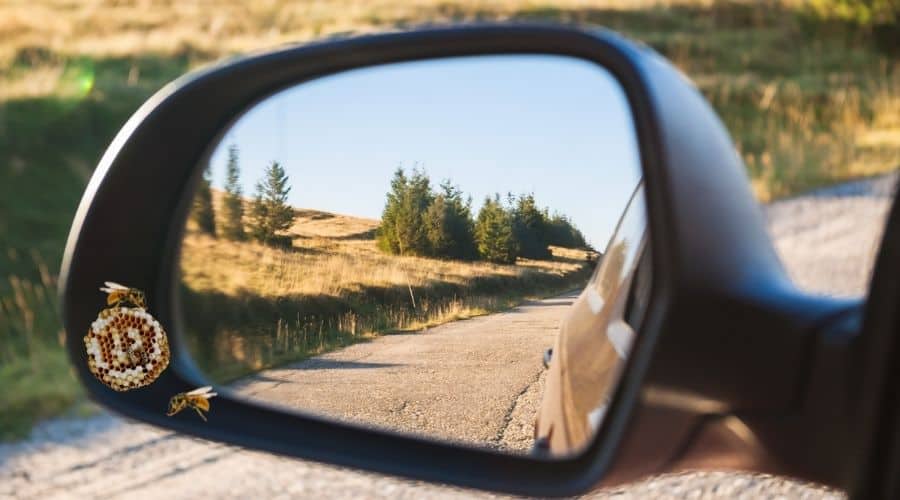Queen wasps will nest in any enclosed space they feel is protected from the elements to keep their colony safe. It can be frightening when you suddenly spot wasps going into the space behind your car mirror.
You don’t want to get stung, especially if it’s paper wasps, which have excruciating stings. How do you remove a wasp nest behind a car mirror?
To remove a wasp nest behind a car mirror, wrap the mirror with a plastic bag with wasp dust poison or pour a few tablespoons of pine sol in it and tie it securely around the mirror at night when the wasps are less active. Let it sit for at least 12 hours before removing the bag.
Table of Contents
3 Ways To Get Rid Of Wasp Nest In Car Mirror
There’s nothing quite like getting in your car only to realize you’ve riled up a nest of wasps nestled behind your mirror.
Since opening the door isn’t as jarring as closing it most of the time, it’s entirely possible to find yourself trapped inside while they swarm.
Infestations aren’t the only reason to ensure you roll up your windows, but it’s a good reminder. Once they calm down and you escape, your priority should be to get rid of the wasp nest in your car mirror.
I’ll show you 3 good ways to tackle this issue.
1 – Suit Up
Pest control can be an exciting challenge for brave and self-sufficient DIYers who are always ready to throw themselves headfirst into any new experience.
The Suit-Up method is best for areas where you’ll probably have to face many situations like this. Paying for pros is safer, but sometimes it’s not in the budget.
This method is best if you can quickly and easily tilt the mirror to the side far enough to get a vacuum hose inside the space.
When the only choice for you is to tackle a wasp nest in full daylight, you’re going to want a beekeeper’s suit and a powerful vacuum like a shop vac with a suitable hose.
You can gear-up and literally suck the nest out of the space behind your mirror if you have the stomach for it. Please note that this is risky, and you may get stung, especially if you are new to wasp removal.
Fortunately, beekeeper suits are easy to find.
I recommend the Bees & Co U74 Natural Cotton Beekeeper Suit with Fencing Veil from Amazon. Not only is this a reputable, high-quality brand, but Bees & Co has sizing from extra small to 6 xl.
There are lots of pockets and elastic where you need it most to keep wasps (or bees) out of your suit. Best of all, the U74 comes with a two-year warranty.
- Beekeeping suit natural cotton with removable fencing veil
- Elasticated waistband and elasticated cuffs, plus elastic thumb loops to keep everything comfortably in place
- Three pockets, cotton knee pads and two leg hive tool pockets
- Heavy duty zippers, durable double-stitched pockets, and two year warranty
- Unisex bee suit design for men and women
2 – Spray & Wait
The bag and spray method works best when you can wait a whole day to drive again. Use this method on less aggressive species that don’t fly at night.
Wait until the nest has gone inactive for the night. Dusk and dawn are smart times to go after a nest.
Do It Best recommends, “…even if you have the urge to be a sadistic fiend, don’t get up close and personal. Plan to attack from a safe distance. These sprays usually propel their insecticide about 20 feet, with some traveling as far as 29 feet. That means there is no good reason to be too close. And never stand directly underneath what you’re spraying…make sure the wind is at your back when you spray, not blowing towards your face.”
Once you’ve sprayed the nest and mirror, get away quickly in case any wasps emerge. Leave the spray on for 24 hours before returning to check that all the wasps are dead and there’s no activity.
3 – Dust & Debride
When the wasp nest isn’t exposed, you can opt for insecticidal dust around the edges where the wasps get inside.
This method is best when it’s not going to rain soon and even better if it’s not going to be windy. You can also apply dust to aggressive colonies when they’re sleeping without disturbing them much.
I recommend using Delta Dust Pest Insecticide w/Puffer Bellow Hand Duster from Amazon because it’s got everything you need to work quickly. You’ll appreciate how well this works in the crevices around your mirrors.
- Active Ingredient: 0.05% Deltamethrin Target pests: Ants, Bedbugs, Cockroaches, Fleas, Silverfish, Scorpions, Sowbugs, Millipedes, and numerous other pests. For use in: Cracks and Crevices indoors and outdoors Application area: 1 lb. delta dust treats approx. 1000sq/ft. You MUST ALWAYS READ THE LABEL BEFORE USING THE PRODUCT!!
- ALWAYS READ THE LABEL BEFORE USE!! ~ Delta Dust Can Not Be Shipped to New York see my amazon store for Drione
Once you’ve let your dust do its job for twelve to forty-eight hours, depending on what the manufacturer recommends, you can check the nest. It should be dead.
After that, turn the mirror and pull the nest out with gloved hands. For mirrors that won’t turn due to blockage, you may need to break up the nest first using a slim-jim or sturdy piece of curved wire that fits through the gap around your mirror.
Why Do Wasps Like Side Mirrors
The side mirrors on cars have a gap behind the adjustable mirror. If you are a tiny insect looking for a sheltered space to build a home, that space is relatively undisturbed and calm, so it makes an ideal getaway.
Wasps like side mirrors in cars because they offer the proper privacy and protection.
Moreover, a car-adjacent location may come with bonus messes from humans like crumbs that draw other insects. Wasps kill and pre-chew other bugs to feed their larvae. Messy humans provide easy access to prey.
Helpful Tips To Know About How To Remove Wasp Nest Behind Car Mirror
A wasp nest behind your car mirror looks scary, and it can be a challenge to tackle, but most of the time, you can handle it yourself with no injuries.
It’s important to spray at night when the wasps are inactive. You’ll also want to avoid jiggling the mirror as the vibrations will rile up the wasps, and they will still come out if they feel attacked.
Here are more helpful tips to know about how to remove a wasp nest behind a car mirror.
- Once you have gotten rid of the wasps in your mirror, you need to prevent future colonies from taking over that obviously desirable space. The easiest and most pleasant way to do this is to get a small squirt bottle and fill it with peppermint essential oil. Spritz around the mirror after every rain to deter new queens from moving in. Amco Ranger Pest Solutions confirms, “Not only do wasps stay away from spearmint, but they also don’t seem to like any type of mint, which is why peppermint oil can be so effective at repelling them. A study published in the Journal of Pest Management Science in 2013 reported outstanding results with peppermint oil.”
- Some wasps fly at night. According to School Of Bees, “Even though most wasps do not fly at night, Hornets do. The European hornet, which is the only species of hornets you will find in the United States, Apoica wasps, Ichneumonid wasps, and Braconid wasps fly at night if the weather is calm.”
- There are over thirty thousand identified species of wasps globally, and roughly 4,000 of those live in America. It’s important to understand that some species are more painful or aggressive than others. If possible, I recommend identifying the wasps building a home behind your car mirror.
- Both WD40 and Pine-Sol are said to kill wasps. I would not recommend trying these DIY solutions. However, it’s helpful to know about these if you don’t have access to other wasp poison options. If you must improvise, please be cautious and use the bag-over-mirror trick to keep the wasps inside until they die.
Final Thoughts
Wasps behind your car mirror are a serious issue. They can get into your car while driving or sting you when you are entering and exiting if they feel threatened.
Naturally, you want to be able to use your vehicle safely, so the only solution is to get rid of these dangerous pests. Even if you’re not allergic to them, wasps can cause you a significant amount of pain.
Moreover, once a wasp stings you, it marks you chemically as a threat, and all the other wasps in the colony can smell the marker, so they’re more likely to come after you.
If there are wasps behind your car mirror or anywhere on your vehicle, you should treat them as a threat and dispose of them properly and safely as soon as possible.



